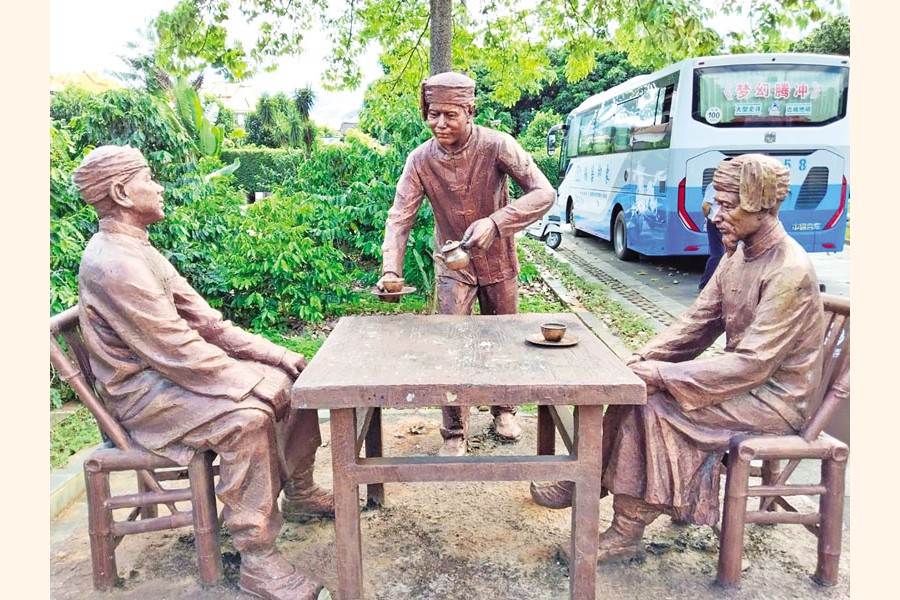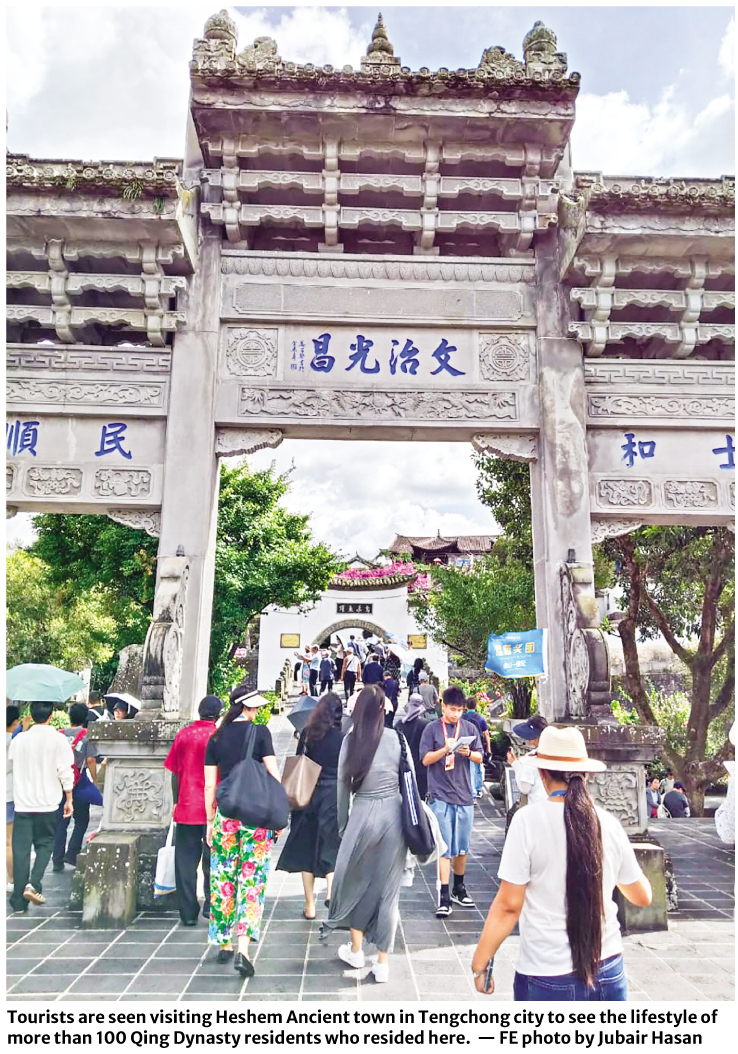AN EPOCH-CHANGING EQUITABLE DEVELOPMENT MODEL
Rural tourism integrates backwoods household production units into China's mammoth mainstream economy
Extreme poverty eradicated, villagers' per-capita income doubles in four years under flagship recipe

JUBAIR HASAN Back from Kunming, China
Published :
Updated :

A special model of development parity with tourism as the pivot unlocks untapped potential in the backwoods and integrates rural-household production units into world's most dynamic economic powerhouse, yielding quantum leaps in income.
This is how China pulled up millions of people from under poverty line in far-flung areas of a vast country on back of a time-bound flagship programme aimed at bringing parity in its modern-day market-driven socialist economy.
Firsthand accounts show how the special recipe, styled 'Rural Tourism', bottom-upped socioeconomic life in China's rural areas through generating income-boosting employment opportunities.
The Chinese government is not only revitalising village communities through bridging the urban-rural development gaps but also fighting out poverty by preserving cultural heritage for generations to come.
As it has become a widely success story in stopping inter-and intra-region worker migration with expanding job opportunities in the villages, the number of villages embracing rural- tourism concept continues to grow and the Communist Party of China, a socialist party that rules the world's second-largest, most dynamic economy, keeps on investing heavily to develop basic facilities in a well-structured way to host both local and overseas tourists.
From Jinggangshan to Yiyuan, Boao to Baoshan, the flagship project having enough materials to alleviate poverty keeps spreading all around regions, making significant contribution to the rural economic regeneration for the once-neglected backward people.
Wang Dayong, who cultivates coffee in Xingzhai village located in Lujiang Town of Baoshan City in Yunnan Province, has a story to tell as to how the model works like a magic wand. He says Xingzhai village is known as China's number/1 coffee village, for innovative farming and catering to variegated tastes of consumers in the East and the West of the globalized world community.
He says they have been developing various varieties of coffee, including the Baoshan Arabica one, in this area around Gaoligong Mountain because the climate is too good for producing such varieties.
The coffee cultivator says the Chinese government built the necessary infrastructure like roads in this hilly area, and power and water facilities. "We also got formal credits at a subsidised rate from financial institutions with insurance backup and the government agencies concerned used to communicate with us on a regular basis if the production needs any further assistance," he says, elaborating on how the development-economic model works.
Mr. Dayong says there are 100 people working in the coffee estate and each received ¥4000 per month last year. They managed to produce 30 metric tonnes of coffee. "We expect the production will go up to 50 metric tonnes this year and next year it will reach 100 metric tonnes,"
A 50-year-old worker in the coffee estate says she used to earn less than ¥2000 before joining in the production base. "Now, I got ¥4000 a month. This place changes my life. I am very happy," she narrates her lifestyle change, flashing a smile on her face.
Zuo Xiufa, who comes from east China's Jiangxi Province that is one of the first Chinese cities totally taken off the list of impoverished areas by applying such strategy, visited Heshun Ancient Town in Tengchong City of Yunnan province in September 19, 2025. He says his entire family come to see the place because it was home of more than 100 Qing Dynasty residences, featuring a blend of Chinese and Western architectural styles.
"I also bring my wife and two children, letting them experience the Chinese heritage and caravan culture. We heard that this cultural tapestry has made Heshun one of the Yunnan Province's four exemplary eco-cultural villages," he tells a visiting media team.
Like Xiufa, thousands of Chinese people travel such locations in various corners of the sprawling country each year and these movements of people help bring economic vibrancy in the remote villages through creating jobs and business opportunities.
The Government of China, led by President Xi Jingpin, put utmost focus on a special concept to bring further speed in the country's ongoing poverty-alleviation campaign since 2013 for achieving the government's target of eliminating extreme poverty by 2020 when the ruling Communist Party of China (CPC) celebrated its centenary (100 years of founding).
At the end of 2020, through eight years of hard work, China achieved the goal of eliminating extreme poverty-a key goal for the new era of building socialism with Chinese characteristics. The 98.99- million people in rural areas who were living below the current poverty threshold all shook off poverty. All the 128,000 impoverished villages and 832 designated poor counties got rid of poverty.
China has eliminated poverty over entire regions and eradicated extreme poverty, according to 'Poverty Alleviation: China's Experience and Contribution' report released by The State Council Information Office of the People's Republic of China in 2021.
Under the project, the Chinese government identified areas of extreme poor and properly analysed the climate there to understand what will be the most suitable agricultural produce in such villages.
Then the government largely invested in the rural regions over the years developing tourism-friendly physical infrastructure like roads, availability of utility services to ensure sound production and connect villages with the mainstream markets.
Simultaneously, the government provides low-cost funding to the farmers through loans with crop- insurance coverage. On the other hand, local administration was instructed to facilitate inbound tourists to travel to the areas to experience how the project helps reshape china's rural landscape.
Rural or agriculture tourism is basically a sustainable anti-poverty package involving five key things. Firstly, it reshapes economy of the locality by taking care of the most potential economic areas like crop production, fishing, vegetable cultivation, flower farming.

Secondly, this trade helps in building affordable houses with basic facilities like sanitation, supply of pure drinking water for the locals.
Thirdly, it builds up social security and welfare that includes pension, medical insurance, commercial insurance and subsistence.
Fourth, it provides required finances from the banking system.
And last, but not the least, necessary infrastructures like roads connecting each household with the mainstream market economy are being built.
The economic-innovation initiative also facilitates the villagers to form cooperative-driven cultivation practices to reap decent profits by joining hands.
According to data from the Ministry of Culture and Tourism of the People's Republic of China, some 1,200 villages and 100 towns have been included in the national list of key villages and towns for rural tourism to date.
The data also show that the total number of tourist visits received by the national rural tourism sector reached 707 million in the first quarter of 2025, a year-on-year increase of 8.9 per cent.
The total revenue reached ¥412 billion, up 5.6 per cent year on year, and the total number of people employed in rural tourism stood at 7.12 million in an increase of 2.2 per cent compared to the same period last year.
According to data from the National Bureau of Statistics of China, in the first quarter of 2025, driven by increased travels during the Spring Festival and improved business conditions in rural tourism, the per-capita net operating income from tertiary industries for rural residents grew by 10.9 per cent.
As a key member of the China's flagship project called Belt and Road Initiative (BRI), Bangladesh having enough potential can learn more about the successful intervention and try to apply it of its own for rural economic regeneration, which is a key to overcoming the development disparity between urban and rural areas.
jubairfe1980@gmail.com


 For all latest news, follow The Financial Express Google News channel.
For all latest news, follow The Financial Express Google News channel.